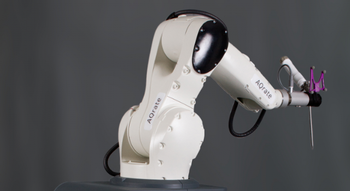KB Medical SA is a Swiss company focusing on the design, development and commercialization of the AQrate(TM) robotic system to empower surgeons with precise, cost-effective, robotic-assisted spinal and neuro surgery. The solution, initially designed for spinal surgery, has the strength required for orthopedic-surgery and the accuracy required for neuro-surgery. The Company’s mission is to provide a robotic system specifically designed for spinal and neuro surgery, and to integrate imaging, navigation, implants, instruments and robotics to work as a full solution to support minimally invasive surgery. The system integrates seamlessly into existing operating rooms and does not disrupt the workflow or standard procedure steps owing to its reliability and ease of use. The AQrate (Spine) solution is fully industrialized, expecting CE Mark by May 2016, and successfully validated by leading surgeons worldwide.
The objective of the project, initially defined by a group of spinal surgeons, is to develop a system solution enabled by a haptic robot with intra-planning steering capabilities and requiring minimal change in the operating flow, which (i) provides the required accuracy and stability of the planned trajectory during percutaneous spinal surgery, and (ii) simplifies the procedure by integrating the benefits of imaging, navigation, dedicated implants and instruments to reduce time of surgery while increasing the overall safety for the patient and the surgical staff (less exposure to imaging radiation).
The underlying technology includes haptic robot control, algorithms for no-go/stay-in zones, virtual ease or resistance in trajectories, motion tracking, active stability, re-registration of imaging and navigation based on detection of anatomy, and design of robot-enabled instrumentation and techniques to reduce the number of surgical steps.
While these elements of the solution independently represent incremental yet significant innovation, the combination and the integration of imaging, navigation, instruments and implants enabled by the robot clearly enable a disruptive solution with the clear potential to enable large-scale adoption of minimally invasive spinal surgery.
The AQrate(TM) includes both a robotic and a software platform. The robot is mounted on a cart and is wheeled at the operating table. Wheels are then retracted and the cart rests on rugged feet for maximum stability. The overall space taken at operating table is small, as specified in by the surgeons during the initial definition of their ideal solution.
The robotic platform includes a medical-grade industrial robotic arm providing the required strength and accuracy at an affordable cost. A steering handle is attached to the tip of the robotic arm via a 6-axis force sensor to provide haptic steering and force-feed-back. Standard instruments can be attached to the steering handle and recognized automatically by weight and inertia.
The software platform includes a host of steering and assistance algorithms, and can access information from both imaging and navigation devices.
Once the robot is stabilized at the operating table, the surgeon adapts its instruments to the steering handle and grabs that handle as if he or she were holding the instrument itself. The robot will then follow the motion of the surgeon who positions the instruments to the right entry point and trajectory, checking the the navigation device. Once the instrument in place, the surgeon sets the robot in steady mode to actively maintain the trajectory while he or she performs whatever surgical step is required (drilling, tapping, screwing, …). All sorts of algorithms make the work easier, faster and safer.
News
Milestones/News
Documents
Videos and Presentations
EPFL Operation Robot - Precision to within One Tenth of a Millimeter
KB Medical presentation PERL Prize





